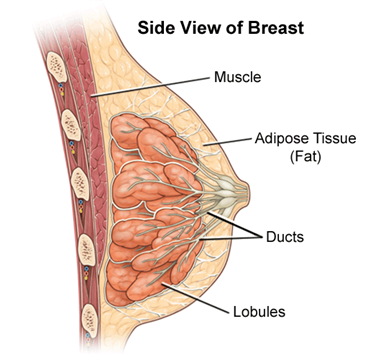Breast Disorders and Diagnostics
What is Breast ultrasound?
Breast ultrasound is an imaging test that uses sound waves to look at the inside of your breasts. It can help your healthcare provider find breast problems. It also lets your healthcare provider see how well blood is flowing to areas in your breasts. This test is often used when a change has been seen on a mammogram or when a change is felt, but does not show up on a mammogram.

The healthcare provider moves a wand-like device called a transducer over your skin to make the images of your breasts. The transducer sends out sound waves that bounce off your breast tissue. The sound waves are too high-pitched for you to hear. The transducer then picks up the bounced sound waves. These are made into pictures of the inside of your breasts.
Your healthcare provider can add another device called a Doppler probe to the transducer. This probe lets your healthcare provider hear the sound waves the transducer sends out. He or she can hear how fast blood is flowing through a blood vessel and in which direction it is flowing. No sound or a faint sound may mean that you have a blockage in the flow.
Ultrasound is safe to have during pregnancy because it does not use radiation. It is also safe for people who are allergic to contrast dye because it does not use dye.
Why might I need a breast ultrasound?
A breast ultrasound is most often done to find out if a problem found by a mammogram or physical exam of the breast may be a cyst filled with fluid or a solid tumor.

Breast ultrasound is not usually done to screen for breast cancer. This is because it may miss some early signs of cancer. An example of early signs that may not show up on ultrasound are tiny calcium deposits called microcalcifications.
Ultrasound may be used if you:
- Have particularly dense breast tissue. A mammogram may not be able to see through the tissue.
- Are pregnant. Mammography uses radiation, but ultrasound does not. This makes it safer for the fetus.
- Are younger than age 25
Your healthcare provider may also use ultrasound to look at nearby lymph nodes, help guide a needle during a biopsy, or to remove fluid from a cyst.
Your healthcare provider may have other reasons to recommend a breast ultrasound.
What are the risks of a breast ultrasound?
A breast ultrasound has no risk from radiation. It poses no risk to pregnant women.
Breast ultrasound may miss small lumps or solid tumors that are commonly found with mammography. Being obese or having very large breasts may make the ultrasound less accurate.
You may have risks depending on your specific health condition. Be sure to talk with your healthcare provider about any concerns you have before the procedure.
What is Breast Cosmetics?
There are three general categories of cosmetic surgery performed on the breasts (also called mammoplasty): breast augmentation, breast reduction, and breast reconstruction.
Breast Augmentation (Augmentation Mammoplasty)
Breast augmentation is performed to enhance the appearance, size, and contour of a woman’s breasts. Women consider breast augmentation for many different reasons. Some women feel their breasts are too small. Some desire augmentation after their breasts change after pregnancy. Others desire to correct an asymmetry in breast size.
Breast augmentation is performed with implants (see below) that can be placed under a chest muscle or over a chest muscle. The incision can be placed in the axilla (armpit), areola (the area surrounding the nipple), or lower breast fold. In general, all breast augmentations are minimally invasive procedures. For augmentations in which the incision is made in the armpit, an endoscope (thin tube with a small camera and light) may be used during the procedure.
Breast implants are made up of a silicone shell filled with either saline (a salt water solution) or silicone gel. Women determine their desired size by fitting trial implants. Currently, saline filled implants are used on an unrestricted basis. Silicone gel filled implants, once banned by the FDA, are available only to women participating in approved studies.
Breast augmentation is a relatively straightforward procedure. As with any surgery, some uncertainty and risk are expected. Know your concerns and expectations. Review the benefits, risks, and alternatives. Seek consultation with a board certified plastic surgeon.
Breast Reduction
Breast reduction surgery is often used in women with large, heavy breasts who experience significant discomfort including neck pain, back pain, and numbness or weakness due to the weight of the breasts. During this procedure, excess skin, fat, and breast tissue are removed.
After surgery, breast reduction can cause a change in breast sensation as well as the inability to breastfeed.
After breast reduction, most women report relief from the symptoms caused by having oversized breasts. For more on this topic, see the article on breast reduction surgery.
Breast Reconstruction
Breast reconstruction surgery is often performed in women who undergo mastectomy as a treatment for breast cancer.
